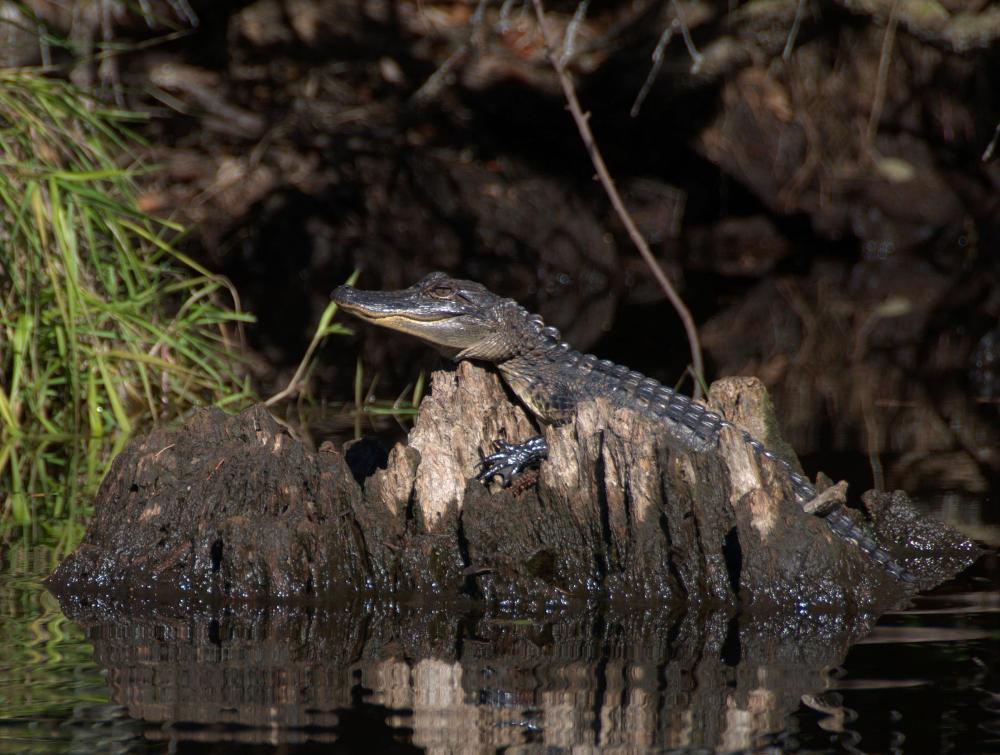One of the world’s most important wetlands is under attack

A small alligator sits on a tree stump in Okefenokee National Wildlife Refuge
Steve Brooks
Strip mining threatens to devastate Georgia’s treasured Okefenokee Swamp
Growing up in rural New York, I would often schlep through the forest behind my house to a stretch of undeveloped wetland that was part of New York’s “Great Swamp.” I was always amazed by the number of critters I encountered: beavers, mink, foxes, crayfish, coyotes, all manner of marshland birds. That swamp felt like an endless paradise as a kid, though I had no idea at the time just how important wetlands like it are.
That small stretch of wetland pales in comparison to Georgia’s Okefenokee Swamp. Comprising over 400,000 acres, the Okefenokee Swamp is North America’s largest blackwater wetland and one of its oldest. Its significance as one of the world’s largest intact freshwater ecosystems led it to be designated a Wetland of International Importance by the Ramsar Convention, and its lack of development makes it an International Dark Sky Park.
Today, the Okefenokee Swamp is largely protected by the Okefenokee National Wildlife Refuge, but a strip mining project proposed on Trail Ridge just east of the refuge threatens to devastate the fragile ecosystem. For the sake of the plants, animals, and people for whom Okefenokee has been a home, this development cannot be allowed to continue.
Old blackwater keep on rolling
While “black water” was referenced by The Doobie Brothers in their 1975 hit, blackwater is more than just a descriptive term. Waters like the Okefenokee are generally slow-moving, and as a result organic compounds called tannins (yes, like in red wine) released from decaying vegetation “stain” the water black. The tannins also cause the water to be more acidic than average.
This acidity helps give wetlands like Okefenokee their own unique ecosystem. Indeed, the swamp is home to roughly 1,000 species of plants and animals. Though the most iconic inhabitant is certainly the American alligator—a whopping 15,000 inhabit the swamp—it also provides vital habitat for threatened and endangered species like red-cockaded woodpeckers, eastern indigo snakes and the Florida black bear.
A rich human history
Perhaps in part due to its biodiversity and abundance of fresh water, the Okefenokee provided a home to several Indigenous communities for centuries, including Muscogee, Timucuan and Seminole people. The English name “Okefenokee” is in fact believed to be derived from Indigenous names for the region. Though these communities were violently driven from the area by white settlers, the swamp is still culturally significant land containing historical sites and burial grounds.
The Okefenokee was briefly inhabited by white settlers following the ousting of Indigenous communities. These so-called “swampers” lived largely isolated and self-sufficient lives until the turn of the 20th century when industrial developers snatched up the land. The swamp was briefly logged during the early century, successful advocacy by local communities led the federal government to purchase the land and create the wildlife refuge in 1937.
Renewed threats
While the swamp itself is now permanently protected, a strip mine proposed by Twin Pines Minerals on unprotected land at the edge of the refuge threatens to devastate the ecosystem. The mine would sit on a critical ridge formation that helps anchor the swamp, and with a devastating 8,000 acre footprint it would leave no sand undisturbed.
Twin Pines claims their project would not disturb the health of the swamp, but scientists and activists have blasted the company’s poor track record and fatally flawed impact assessment. Make no mistake—this mine could devastate the Okefenokee, and the impacts of such a loss would be felt far beyond Georgia.
Georgia’s Environmental Protection Division is currently accepting public comments on Twin Pines’ land use proposal, and we need as many people as possible to flood their inbox with opposition. Please, leave a comment before March 20 urging Georgia to stop this destructive project and protect Okefenokee!
